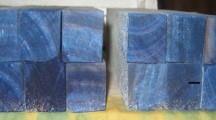Abstract
In this study, the use of polyvinyl alcohol (PVA) as boron fixative agent was investigated. Two levels of PVA (2.5 and 4%) were evaluated with disodium octaborate tetrahydrate (DOT) at three concentrations (1, 2 and 4% boric acid equivalent (BAE)) using a double vacuum impregnation process on Scots pine sapwood specimens. Leaching was performed according to a laboratory leaching procedure. Boron analysis using atomic absorption spectrometer showed a significant reduction in boron leachability for the samples treated with both concentrations of PVA when compared to the stand-alone boron treatment leading to boron retentions capable of preventing wood biological degradations. Decay resistance of the leached specimens was evaluated using the brown rot fungus Poria placenta. Even if complete protection was not fully achieved, an improvement in decay resistance was observed for the samples treated with DOT in presence of PVA. This leak of efficacy was attributed to a decrease in the biological activity of the complexed boron against fungi. Durability of treated wood against termite attack, evaluated using Reticulitermes santonensis, indicated a significant enhancement for the samples treated in presence of the fixative agent compared to the pure boron treatment.





Similar content being viewed by others
References
Baysal E, Ozaki SK, Yalinkilic MK (2004) Dimensional stabilization of wood treated with furfuryl alcohol catalysed by borates. Wood Sci Technol 38:405–415
Drysdale AJ (1994) Boron treatments for the preservation of wood—a review of efficacy data for fungi and termites. IRG/WP 94-30037. International Research Group on Wood Preservation, Stockholm
European Committee for Standardization (1990) Wood preservatives—Determination of toxic values against Reticulitermes santonensis de Feytaud (laboratory method). NF EN 117
European committee for standardization (1994) Wood preservatives—methods for measuring losses of active ingredients and other preservative ingredients from treated timber—part 2: laboratory method for obtaining samples for analysis to measure losses by leaching into water or synthetic sea water. ENV 1250-2, Brussels
Gezer ED, Michael JH, Morrell JJ (1999) Effects of glycol on leachability and efficacy of boron wood preservatives. Wood Fiber Sci 31:136–142
Kartal SN, Green F (2003) Leachability of boron from wood treated with natural and semi-synthetic polymers and calcium precipitating agent. Holz Roh- Werkst. 61:388–389
Kartal SN, Imamura Y (2004) Effects of N′-N-(1, 8-naphthalyl)hydroxylamine (NHA-Na) and hydroxynaphthalimide (NHA-H) on boron leachability and biological degradation of wood. Holz Roh- Werkst 62:378–385
Kartal SN, Yoshimura T, Imamura Y (2004) Decay and termite resistance of boron-treated and chemically modified wood by in situ co-polymerisation of allyl glycidyl ether (AGE) with methyl methacryalte (MMA). Int Biodeterior Biodegradation 53:111–117
Kartal SN, Yoshimura T, Imamura Y (2009) Modification of wood with Si compounds to limit boron leaching from treated wood and to increase termite decay resistance. Int Biodeterior Biodegradation 63:187–190
Lin HL, Liu WH, Liu YF, Cheng CH (2002) Complexation equilibrium constants of poly(vinyl alcohol)-borax dilute aqueous solutions—Consideration of electrostatic charge repulsion and free ion charge shielding effect. J Polym Res 9(4):233–238
Lloyd JD (1998) Borates and their biological applications. IRG/WP 98–30178. International Research Group on Wood Preservation, Stockholm
Lloyd JD, Dickinson DJ, Murphy RJ (1990) The probable mechanisms of action of boric acid and borates as wood preservatives. IRG/WP 1450. International Research Group on Wood Preservation, Stockholm
Lyon F, Thévenon MF, Hwang WJ, Imamura Y, Pizzi A (2007) Effect of an oil heat treatment on the leachability and biological resistance of boric acid impregnated wood. Ann For Sci 64:673–678
Mohareb A, Van Acker J, Stevens M (2002) Effect of protective additives on leachability and efficacy of borate treated wood. IRG/WP 02-30290. International Research Group on Wood Preservation, Stockholm
Mohareb A, Van Acker J, Stevens M (2004) Leachability and efficacy of fatty acid derived boron esters as wood preservatives. IRG/WP 04-30351. International Research Group on Wood Preservation, Stockholm
Mourant D, Yang DQ, Lu X, Riedl B, Roy C (2009) Copper and boron fixation in wood by pyrolytic resins. Bioresour Technol 100:1442–1449
Obanda DN, Shupe FT, Barnes HM (2008) Reducing leaching of boron based wood preservatives—A review of research. Bioresour Technol 99:7312–7322
Schoeman WM, Lloyd JD (1998) International standardisation: a hypothetical case study with stand-alone borate wood preservatives. IRG/WP 98-20147. International Research Group on Wood Preservation, Stockholm
Temiz A, Alfredsen G, Eikenes M, Terziev N (2008) Decay resistance of wood treated with boric acid and tall oil derivates. Bioresour Technol 99:2102–2106
Thévenon MF, Pizzi A (2003) Polyborate ions’ influence on the durability of wood treated with non-toxic protein borate preservatives. Holz Roh- Werkst 61:457–464
Thévenon MF, Pizzi A, Haluk JP (1997) Non-toxic albumin and soja protein borates as ground-contact wood preservatives. Holz Roh- Werkst 55:293–296
Thévenon MF, Pizzi A, Haluk JP (1998) Protein borates as non-toxic, long-term, wide-spectrum, ground-contact wood preservatives. Holzforschung 52:241–248
Toussaint-Dauvergne E, Soulounganga P, Gérardin P, Loubinoux B (2000) Glycerol/glyoxal: a new boron fixation system for wood preservation and dimensional stabilization. Holzforschung 54:123–126
Weining C, Kamdem DP (1999) Bioefficacy of boric acid grafted onto wood. IRG/WP/30302. The International Research Group on Wood Preservation, Stockholm
Acknowledgments
The authors would like to thank Mr. Stéphane Parant from UMR UHP SCRSMC for his assistance during utilization of the atomic absorption spectrometer. The authors also gratefully acknowledge the financial support of the CPER 2007-2013 “Structuration du Pôle de Compétitivité Fibres Grand’Est” (Competitiveness Fibre Cluster). Finally, the authors would like to thank the Agence Universitaire de la Francophonie (AUF) for the post-doctoral fellowship granted to the first author.
Author information
Authors and Affiliations
Corresponding author
Rights and permissions
About this article
Cite this article
Mohareb, A., Thévenon, M.F., Wozniak, E. et al. Effects of polyvinyl alcohol on leachability and efficacy of boron wood preservatives against fungal decay and termite attack. Wood Sci Technol 45, 407–417 (2011). https://doi.org/10.1007/s00226-010-0344-4
Received:
Published:
Issue Date:
DOI: https://doi.org/10.1007/s00226-010-0344-4




